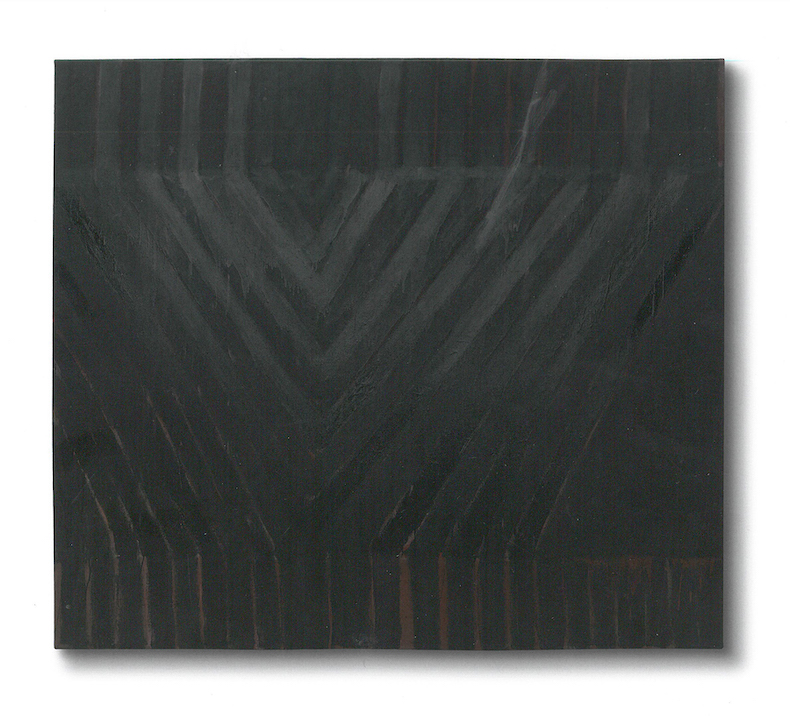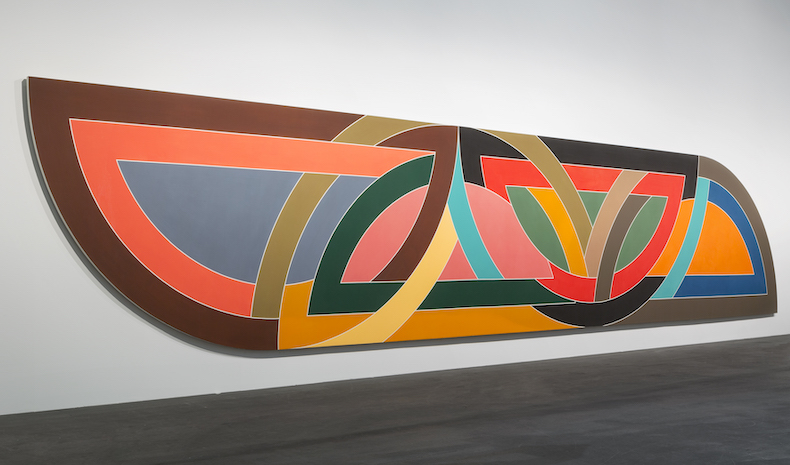Frank Stella, who died on 4 May at the age of 87, was only 23 when a clutch of his Black Paintings was included in ‘16 Americans’ at the Museum of Modern Art in New York. The critic Irving Sandler later described them as the most important paintings of the 1960s: the fact that the show opened in 1959 says everything about their agenda-setting power. They were intensely dark, glossy pictures, severely and impersonally structured with grid patterns, optically indigestible in their scale and patterning. With stretcher bars as thick as the stripes themselves, they were also fat – like ‘slabs’, thought Donald Judd. Minimalists such as Judd adored their anti-pictorial, thing-like quality, while the critic Michael Fried thought that what mattered in them was precisely how they threw off their ‘objecthood’ to achieve ethereal qualities. That quarrel, central to mid ’60s debate, would be called by some ‘the battle for Stella’s soul’, and it raged on even while the young painter strived to reproduce that first success. Even his choice of portrait for the catalogue of ‘16 Americans’ caused an upset: he sent in a photograph of himself in a pin-stripe suit, sardonically riffing on his pictures while also suggesting that, like some lordly executive, he had merely commissioned their manufacture. Even the hint of such a thing was anathema to a generation raised on the Abstract Expressionist values of authenticity and spontaneity, and curator Dorothy Miller sent the picture back hoping for a more conventional shot of the brooding artist in his studio. Stella declined.

Delta (1958), Frank Stella. Courtesy Sprüth Magers; © 2024 Frank Stella/Artists Rights Society (ARS), New York
He was born in 1936 in Malden, Massachusetts, the son of a doctor. He attended the prestigious Phillips Academy, then took medieval history at Princeton while painting in his spare time. He began his career with abstraction, and he would end with it. It made him more and more of a fascinating outlier as time passed, leaving him as one of the very last major painters alive whose work was firmly rooted in the concerns of late modernism. He said that the tone of the Black Paintings was set by was the mood of New York’s underbelly. Even while he flouted its demand for the expressive gesture, he shared Abstract Expressionism’s concern with form and composition, and he would continue to do so as his works became steadily more colourful and buoyant in mood through the 1960s. The extent of his bountiful invention in those early years is suggested by the Protractor series, a sequence based on layered semi-circles. To look at the best of them is to grapple with a puzzle of lines and colours interlacing and interlocking, struggling to follow their progress and divine their purpose. In those years Stella’s moves set fashions: when he began to paint using eccentrically shaped canvases, Michael Fried decided that shape and perimeter were the new issues for painting, not the internal composition of the work, and indeed the shaped canvas remained a seductive idea for painters up through the likes of Elizabeth Murray in the 1980s. But Stella’s achievement transcended these stylish tricks. At its best, his work recalled the possibility and validity of one of the great dreams of modern geometric art, to take high abstraction out of the gallery and into the public world. Those who remember the art that once defiled leisure centres and brutalist bus stations in the 1970s will remember where that dream died, but Stella made it seem possible. His early career was thought so rich as to warrant a retrospective at MoMA as early as 1970, when he was 33, making him the youngest artist ever to be accorded the honour.

Damascus Gate (Stretch Variation I) (1970), Frank Stella. Photo: Renato Ghiazza; courtesy Sprüth Magers; © 2024 Frank Stella/Artists Rights Society (ARS), New York
By the 1980s, his art had adopted all the trappings of postmodernism, becoming a riot of layered motifs, grids and squiggles and an assortment of apparently synthetic, readymade motifs. He also started to use aluminium to bring the imagery off the wall, making it boldly sculptural. Here he reached his most frothy, figurative and heedlessly decorative; he seemed more Pop than minimalist. Stella called it ‘Maximalism’, and he essentially maintained that mode until his death – indeed his late work evokes the ’80s more than the ’60s. If it made him a favourite for public artworks and corporate lobbies, his former supporters turned away, disappointed and perplexed. But while the late work never had the cerebral power of the early, its sheer cheerfulness made it difficult to dislike and Stella remained a favourite with audiences, so much so that when the new, downtown location of the Whitney Museum opened in 2015, its first major retrospective was devoted to him. In a canny reversal, the old Whitney location closed with a Jeff Koons show, reversing the logical chronology while insisting that Frank Stella’s relevance would never die.

What Frank Stella saw – and what he made us see
Frank Stella at his studio in New York City in 1995. Photo: Bob Berg/Getty Images
Share
Frank Stella, who died on 4 May at the age of 87, was only 23 when a clutch of his Black Paintings was included in ‘16 Americans’ at the Museum of Modern Art in New York. The critic Irving Sandler later described them as the most important paintings of the 1960s: the fact that the show opened in 1959 says everything about their agenda-setting power. They were intensely dark, glossy pictures, severely and impersonally structured with grid patterns, optically indigestible in their scale and patterning. With stretcher bars as thick as the stripes themselves, they were also fat – like ‘slabs’, thought Donald Judd. Minimalists such as Judd adored their anti-pictorial, thing-like quality, while the critic Michael Fried thought that what mattered in them was precisely how they threw off their ‘objecthood’ to achieve ethereal qualities. That quarrel, central to mid ’60s debate, would be called by some ‘the battle for Stella’s soul’, and it raged on even while the young painter strived to reproduce that first success. Even his choice of portrait for the catalogue of ‘16 Americans’ caused an upset: he sent in a photograph of himself in a pin-stripe suit, sardonically riffing on his pictures while also suggesting that, like some lordly executive, he had merely commissioned their manufacture. Even the hint of such a thing was anathema to a generation raised on the Abstract Expressionist values of authenticity and spontaneity, and curator Dorothy Miller sent the picture back hoping for a more conventional shot of the brooding artist in his studio. Stella declined.
Delta (1958), Frank Stella. Courtesy Sprüth Magers; © 2024 Frank Stella/Artists Rights Society (ARS), New York
He was born in 1936 in Malden, Massachusetts, the son of a doctor. He attended the prestigious Phillips Academy, then took medieval history at Princeton while painting in his spare time. He began his career with abstraction, and he would end with it. It made him more and more of a fascinating outlier as time passed, leaving him as one of the very last major painters alive whose work was firmly rooted in the concerns of late modernism. He said that the tone of the Black Paintings was set by was the mood of New York’s underbelly. Even while he flouted its demand for the expressive gesture, he shared Abstract Expressionism’s concern with form and composition, and he would continue to do so as his works became steadily more colourful and buoyant in mood through the 1960s. The extent of his bountiful invention in those early years is suggested by the Protractor series, a sequence based on layered semi-circles. To look at the best of them is to grapple with a puzzle of lines and colours interlacing and interlocking, struggling to follow their progress and divine their purpose. In those years Stella’s moves set fashions: when he began to paint using eccentrically shaped canvases, Michael Fried decided that shape and perimeter were the new issues for painting, not the internal composition of the work, and indeed the shaped canvas remained a seductive idea for painters up through the likes of Elizabeth Murray in the 1980s. But Stella’s achievement transcended these stylish tricks. At its best, his work recalled the possibility and validity of one of the great dreams of modern geometric art, to take high abstraction out of the gallery and into the public world. Those who remember the art that once defiled leisure centres and brutalist bus stations in the 1970s will remember where that dream died, but Stella made it seem possible. His early career was thought so rich as to warrant a retrospective at MoMA as early as 1970, when he was 33, making him the youngest artist ever to be accorded the honour.
Damascus Gate (Stretch Variation I) (1970), Frank Stella. Photo: Renato Ghiazza; courtesy Sprüth Magers; © 2024 Frank Stella/Artists Rights Society (ARS), New York
By the 1980s, his art had adopted all the trappings of postmodernism, becoming a riot of layered motifs, grids and squiggles and an assortment of apparently synthetic, readymade motifs. He also started to use aluminium to bring the imagery off the wall, making it boldly sculptural. Here he reached his most frothy, figurative and heedlessly decorative; he seemed more Pop than minimalist. Stella called it ‘Maximalism’, and he essentially maintained that mode until his death – indeed his late work evokes the ’80s more than the ’60s. If it made him a favourite for public artworks and corporate lobbies, his former supporters turned away, disappointed and perplexed. But while the late work never had the cerebral power of the early, its sheer cheerfulness made it difficult to dislike and Stella remained a favourite with audiences, so much so that when the new, downtown location of the Whitney Museum opened in 2015, its first major retrospective was devoted to him. In a canny reversal, the old Whitney location closed with a Jeff Koons show, reversing the logical chronology while insisting that Frank Stella’s relevance would never die.
Unlimited access from just $16 every 3 months
Subscribe to get unlimited and exclusive access to the top art stories, interviews and exhibition reviews.
Share
Recommended for you
The unwavering art of Ellsworth Kelly
On the centenary of the artist’s birth, it is easier to see that beneath the impersonal surfaces his work is teeming with life
Good form – the minimalist magic of Donald Judd
A recent display at MoMA revealed the unexplored depths of an artist whose work sometimes seems all surface
An alternative history of abstract art
A survey of works by women painters makes for an enthralling display, but is the gender of the artists the most important factor?